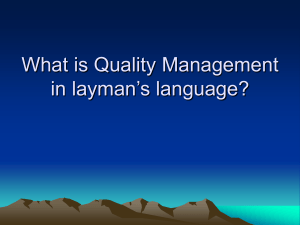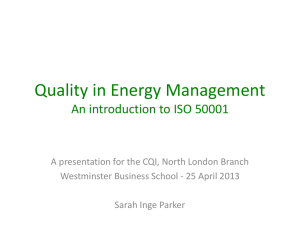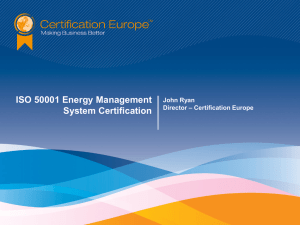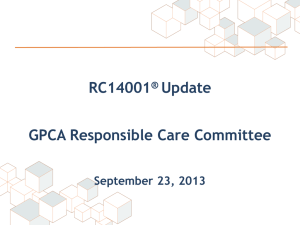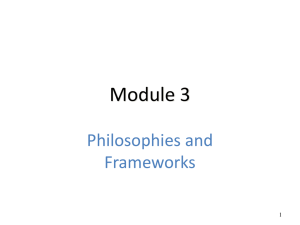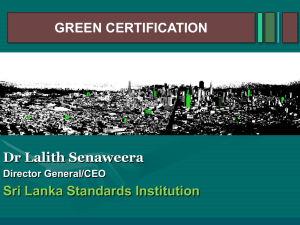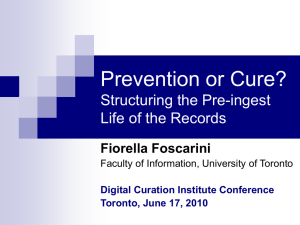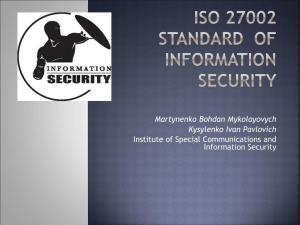Professional Accreditation in the Hotel Industry
advertisement
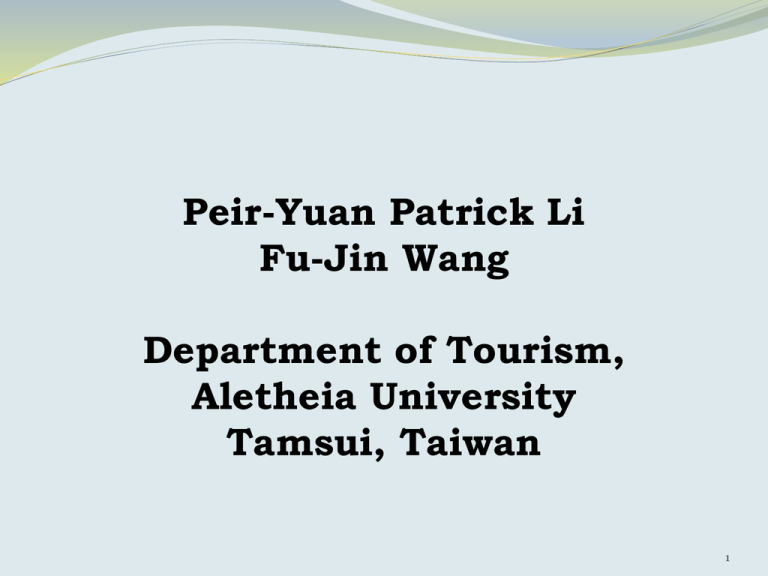
Peir-Yuan Patrick Li Fu-Jin Wang Department of Tourism, Aletheia University Tamsui, Taiwan 1 Professional Accreditation in the Hotel Industry: ISO 22000 Cognition and Reality 2 Research motivation and background Introduction – What is ISO? Food safety and food safety management standard (FSMSs) ISO 22000: 2005 and food chain 3 Methodology Sample and result Conclusion and suggestion Questions 4 5 Project Vanguard for Excellence in Tourism Vision: Creating a tourism environment focusing on both quality and quantity, turning Taiwan into a major tourist destination in Asia 6 Magnificent scenery 7 Bio diversity small islands 8 Folklore, art & culture 9 14 Aborigine tribes 10 Mountain climbing 11 Railroad culture trip 12 Hot spring relaxation 13 12 days around island cycling 14 Taiwanese regional cuisine 15 Research motivation and background “Project Vanguard for Excellence in Tourism” by 1. 2. 3. 4. 5. the Taiwanese Cabinet 2010 Budget of US$237.4 million Project funds will be allocated to the promotion of international tourism, including attracting mainland Chinese tourists 2010 target for mainland tourists is 900,000 Totally 14 tourism development plans Plans for Taiwan to become a tourist transit center in East Asia and an important attraction for international tourism, following the direct transportation links across the Taiwan Strait 16 Research motivation and background “Project Vanguard for Excellence in Tourism” 1.One of the sub projects is intended to improve the general hotel quality 2. Loan-interest subsidies 3. Subsidies for design/ planning expenses 4. Training guidance 5. Encourage initiative by operators to upgrade 6. 256 hotels received assistance from 2004 to 2009; approximately 15,000 guest rooms were improved 17 Research motivation and background “Project Vanguard for Excellence in Tourism” How to improve the general hotel quality? 1. It encourage hotel industry to purse the ISO 22000 and HACCP 2. Most of the expert consultation and assistance cost either obtaining an ISO 22000, HACCP, eco hotel or green hotel could be subsidized by the government fund 18 Introduction The Basics...... 19 What is ISO? International Standards for Business, Government and Society The International Organization for Standardization (ISO) creates many different types of standards ISO is made up of standards institutes from 154 different countries 20 What is ISO 22000? It is a Food Safety Management Standards (FSMSs) that uses a management systems approach as well as a hazard analysis and critical control point (HACCP) process. The goal of ISO 22000 is to provide one internationally recognized standard for a food safety management system that can be applied to any organization in the food chain. 21 FOOD SAFETY MANAGEMENT SYSTEM 22 Food Safety Assurance that food will not cause harm to the consumer when it is prepared and/or eaten according to its intended use. Source: Codex Alimentarius in 1963 (by World Health Organization & Food and Agriculture Organization) 23 Food Safety Protecting People: People may get sick if the food products are not handled carefully Keeping the Employees and Customers: It make the industry better place to work and a place where customers returns Preventing Food Safety Errors: Due to food handling errors during industrial operations any food product can become dangerous 24 Food Safety – Historical Background 1.First HACCP system was developed between NASA and Pillsbury Company in 1971 to prevent the astronaut from getting sick in space. 2.Become a regulatory requirements in European Union since 1998. 3.US Food and Drug Administration also adopted the HACCP approach as part of control mechanism for food safety. 25 Food Safety Management System Why it is required? Intense farming and processing of food Increase in meals consumed outside home Increase in ready to eat foods More traveling across the world Increased amount of exotic imported foods 26 Diverse Food Safety Management System Aldi system DS 3027 FAMI-QS Kraft food system Irish HACCP Nestlé NQS Eurepgap Friesland Coberco FSS GMO McDonalds system ISO 9001 BRC-IoP BRC-Food EFSIS M&S system GMP standard for Corrugated & Solid Board Ducth HACCP GFSI Guide SQF IFS AG 9000 GTP GMP 27 ISO 22000:2005 A management system designed to enable organizations to control food safety hazards along the food chain in order to ensure that food is safe at the time of consumption ISO 22000:2005, clause 1 28 ISO 22000:2005 Features: First global food safety standard. Harmonizes the voluntary international standards. Employs proven management system principles. Enables a common understanding of what a food safety management system is. 29 ISO 22000:2005 Features: Requires legal compliance checking Integrates existing good practice Internal and external monitoring 30 ISO2000:2005 Benefits: Overcomes many of the limitations of traditional approaches to food safety control. Potential to identify all conceivable, reasonably expected hazards. Capable of accommodating the changes. 31 ISO2000:2005 Benefits: Help to target or manage resources to the most critical part of the food operation. Can promote international trade by equalizing food safety control and by increasing confidence in food safety. Applicable to whole food chain. 32 ISO2000:2005 It is designed for the entire food chain: 1.Producers 2.Suppliers 3.Manufactures 4.Distributors 5.Retailers 6. Food service organizations: Hotels Flight catering Contract food service companies. 33 Food chain 34 Entry of Hazards in Food Chain 35 Food chain and process approach Consideration to effect of the food chain on organization’s operation Identification, application and management of a system of processes within the organization Ongoing control over linkage, combination and interaction of individual processes within the system of processes 36 Why does a company need to get certification? The primary reasons why companies go for ISO registration 1. to gain entry into the global market. 2. to maintain and gain competitive position in the global market 3. to improve the company’s image. 4. to improve the company’s operations. Sambasivan and Fei (2007) 38 Preparing for Certification Once you have determine certification is right for your organization and picked the certification scheme, you will need to implement the food safety management system processes to meet requirements of the standard that you choose. These processes must address: Food Safety Management Food Safety Policy Food Safety Manual Management Responsibility Management Commitment Management Review Resource Management Documentation Specifications Procedures Internal Audits Corrective Action Control of Non-conformity Product Release Purchasing Supplier Performance Monitoring Traceability Complaint Handling Serious Incident Management Control of Measuring and Monitoring Product Analysis Prerequisite Programs (PRPs) Hazard Analysis and Critical Control Point (HACCP) Steps to Certification A company will generally begin by conducting a Gap Analysis. This is an audit to compare your current system to the requirements of the standard. The analysis will provide important information on what you will need to implement or change in your organization to prepare for certification. After the Gap Analysis.. The next step is to develop processes or modify current processes to address requirements that are not currently in compliance with the standard. Assigning Responsibilities A Team Structure will make project management organized and efficient Steering Team Led by Project Manager Food Safety Team Led by Food Safety Team Leader Procedure Teams Led by Project Manager Design and Document Processes The Steering Team, led by the project manager, will coordinate the other teams, assign responsibilities and address management requirements. The Food Safety Team, is assigned specific responsibilities by the standard, and will be responsible for some of the procedure development. Each procedure team will design and document the new, compliant process for the procedure they have been assigned. Obtaining Certification Once the procedures are complete and implemented you will have a registrar come to your facility and perform a certification audit. Research methodology 1. The modified Delphi method – group expert judgment method 2. SPSS 12.0 Version (2006) -reliability analysis 3. Expert Choice 2000 Version II (2003) – analyze Analytic Hierarchy Process (AHP) questionnaires 4. The differences among data – Duncan’s multiple range test 46 Experts and scholars team The expert panel including 18 experts were selected utilizing a convenience sampling procedure. The subjects’ were acquired from: a list of registered members obtained from 1.Taiwan food industry research and development institute 2.Chinese HACCP association Experts and scholars team Experts and scholars team Expert and scholars Number of persons Professional background 5 High-level superintendents such as present chefs 6 Doctors of Food Science and Technology in universities, with consulting and auditing competence on HACCP or ISO22000 at least ten years of experience participating in food and beverage practice Production managers of contract food service companies 5 at least ten years of experience participating in food and beverage practice Officers of public health bureau 2 at least ten years of HACCP auditing experience 48 Questionnaire distribution and response analysis Each round of the Delphi was initiated by emailing an invitation message containing a hyperlink to the questionnaire website to expert panel members. A follow-up email message with the hyperlink to the questionnaire website was sent to non-respondents on the seventh day after the first message was emailed. Each round was concluded upon receipt of the expert panel’s responses within two weeks of the first email message. Four dimensions : the main Critical Success Factors of ISO standard implementation 1. The top management ambition and all personnel centripetal forces in the early stage of implementation (Chan and Wong, 2004; Collie and Sparks, 1999; Yeung et al., 2003; Brotherton, 2004; Lamprecht, 1991). 2. The integrity of organizational programming and execution of staff (Lrqa, 1995; Chan and Wong, 2004; Collie and Sparks, 1999). 50 Four dimensions : the main Critical Success Factors of ISO standard implementation 3. The competitive advantage (Taylor, 1995; Stevenson and Barnes, 2002; Chan and Wong, 2004; Kehoe and Mann, 1994). 4. Comprehensive of infrastructure and professional counseling (Biazzo & Bernardi, 2003; Brotherton, 2004). 51 Pre-testing survey 27 peoples include: food and beverage manager, resident manager director of quality assurance executive chef manager of restaurant catering manager executive assistant manager from the nine upscale and mid price hotels 52 Pre-test result Cronbach’s alpha all > 0.70 Dimension mean Cronbach’s alpha The top management ambition 3.08 0.873a and all personnel centripetal forces in the early stage of implementation The integrity of organizational 3.45 programming and execution of staff The competitive advantage 3.97 0.802b Comprehensive of infrastructure and external consultant 0.706c 2.91 0.719c 53 Evaluation dimensions of the second level The top management ambition and all personnel centripetal forces in the early stage of implementation Evaluation criteria in the third level Top management’s carefully phases each stage of implementation and inspects each measurable objective Food safety team leader establishing, maintaining and updating the food safety management with employee’s fully support Top management’s execution and commitment: the discipline of getting things done with external consultants Annual budget to acquire ISO 22000 certification 54 Evaluation dimensions of the second level Evaluation criteria in the third level Establish and maintain traceability system The integrity of organizational programming and execution of staff Appoint a food safety team leader, assemble the team and decide on a strategy To identify and train internal auditor monitoring the food safety team and its work Provide internal as well as external training and educating to enhance execution and cross functionally competent 55 Evaluation dimensions of the second level Evaluation criteria in the third level ISO benefits and market trend The competitive advantage Legislation and penalty Increasing prestige and trustworthiness 56 Evaluation dimensions of the second level Evaluation criteria in the third level Adopted HACCP or ISO 9001 certification as the basis for its food safety management system Comprehensive of infrastructure and external consultant Establish monitor and corrective action procedures Knowledge of Internal auditor to compose the documentation External consultant to assist the interpretation of the requirements 57 AHP questionnaire survey 157 surveys from 29 hotels, three group of stakeholders: 1. the officials and team leaders of hotel inspection and supervision center from government tourism bureau 2. the hotel front of the house personnel 3. the hotel back of the house personnel 58 AHP three basic steps: (1) decomposition, or the hierarchy construction (2) comparative judgments, or defining and executing data collection to obtain pair wise comparison data on elements of the hierarchical structure; (3) synthesis of priorities, or constructing an overall priority rating 59 3 tasks of pairwise comparison (1) developing a comparison matrix at each level of the hierarchy starting from the second level and working down (2) computing the relative weights for each element of the hierarchy (3) estimating the consistency ratio to check the consistency of the judgment 60 Profile of Respondents (N=157) Variable Gender Age Education Department Seniority People Percentage Female 88 56% Male 69 44% 20~29 38 24% 30~39 68 43% 40~49 30 19% Over 50 21 14% Junior high school 2 1% Senior high school 29 18% Some college 36 23% University degree 73 47% Post graduate 17 11% Tourism bureau official 7 5% Front office 23 21% Food & Beverage 44 41% Administration 17 15% Finance 9 9% Engineering 6 5% Others 4 4% 1~3 years 43 27 4~6 years 56 36% 7~9 years 30 19 Over 10 years 29 18 61 Ranking of orders top 3 priority 1. The top management’s execution and commitment: the discipline of getting things done with external consultants 2. Top management’s carefully phases each stage of implementation and inspects each measurable objective 3. Provide internal as well as external training and educating to enhance execution and cross functionally competent 62 1. The top management’s execution and commitment: the discipline of getting things done with external consultants The system costs money and time to develop, implement and maintain Formulation of the food safety policy Top down approach communication to all the employees 63 2. Top management’s carefully phases each stage of implementation and inspects each measurable objective Clearly defined responsibilities and authorities Defined training goals and measurable objectives Goals – Positive, direct, definable, measurable Top management’s dedication 64 3. Provide internal as well as external training and educating to enhance execution and cross functionally competent in the ISO 22000 implementation Internal Trainer External Consultant Usually knows the background and culture of the company Usually has more influence with the company Sometimes encounters resistance because of vested interests and company politics More varied experiences; broader perspective; more objective May lack power base Aware of other resources might helpful to the company Identifies with the company’s needs, pains and inspirations Client company tend to more open with external consultants about needing help 65 4.To increasing prestige and trustworthiness Benefit: prestige and trustworthiness to motivate hoteliers to obtain the accreditation. A firm could lose its competitive position in its international market as well as domestic market by failing to pay attention to food safety management issues 66 The Evaluation Table Dimension The top management ambition and all personnel centripetal forces in the early stage of implementation The integrity of organizational programming and execution of staff The competitive advantage Comprehensive of infrastructure and external consultant Grading 323 287 185 205 Criteria Score Top management’s carefully phases each stage of implementation and inspects each measurable objective Food safety team leader establishing, maintaining and updating the food safety management with employee’s fully support Top management’s execution and commitment: the discipline of getting things done with external consultants Annual budget to acquire ISO 22000 certification Establish and maintain traceability system Appoint a food safety team leader, assemble the team and decide on a strategy To identify and train internal auditor monitoring the food safety team and its work Provide internal as well as external training and educating to enhance execution and cross functionally competent ISO benefits and market trend Legislation and penalty Increasing prestige and trustworthiness Adopted HACCP or ISO 9001 certification as the basis for its food safety management system Establish monitor and corrective action procedures Knowledge of Internal auditor to compose the documentation External consultant to assist the interpretation of the requirements 85 Hotelier self evaluation Certification service co. evaluation 77 88 73 72 60 71 84 65 39 81 45 57 44 59 67 End of Presentation Thank You for your attention Your thoughts? 68


